Charge Transfer in Mixed-Phase TiO2 Photoelectrodes for Perovskite Solar Cells
Abstract
:1. Introduction
2. Materials and Methods
2.1. Materials
2.2. Synthesis of Nanostructured TiO2 Films
2.3. Fabrication of PSCs
2.4. Characterization
3. Results and Discussion
4. Conclusions
Supplementary Materials
Author Contributions
Funding
Conflicts of Interest
References
- Panwara, N.L.; Kaushik, S.C.; Kothari, S. Role of renewable energy sources in environmental protection: A review. Renew. Sustain. Energy Rev. 2011, 15, 1513–1524. [Google Scholar] [CrossRef]
- Reddy, K.G.; Deepak, T.G.; Anjusree, G.S.; Thomas, S.; Vadukumpully, S.; Subramanian, K.R.V.; Nair, S.V.; Nair, A.S. On global energy scenario, dye-sensitized solar cells and the promise of nanotechnology. Phys. Chem. Chem. Phys. 2014, 16, 6838–6858. [Google Scholar] [CrossRef] [PubMed]
- Hosenuzzaman, M.; Rahim, N.A.; Selvaraj, J.; Hasanuzzaman, M.; Malek, A.B.M.A.; Nahar, A. Global prospects, progress, policies, and environmental impact of solar photovoltaic power generation. Renew. Sustain. Energy Rev. 2015, 41, 284–297. [Google Scholar] [CrossRef]
- Yun, S.; Qin, Y.; Uhl, A.R.; Vlachopoulos, N.; Yin, M.; Li, D.; Han, X.; Hagfeldt, A. New-generation integrated devices based on dye-sensitized and perovskite solar cells. Energy Environ. Sci. 2018, 11, 476–526. [Google Scholar] [CrossRef]
- Gratzel, M. The rise of highly efficient and stable perovskite solar cells. Acc. Chem. Res. 2017, 50, 487–491. [Google Scholar] [CrossRef]
- Green, M.A.; Hishikawa, Y.; Dunlop, E.D.; Levi, D.H.; Hohl-Ebinger, J.; Ho-Baillie, A.W.Y. Solar cell efficiency tables (version 52). Prog. Photovolt. Res. Appl. 2018, 26, 427–436. [Google Scholar] [CrossRef]
- Hwang, S.; Larina, L.; Lee, H.; Kim, S.; Choi, K.S.; Jeon, C.; Ahn, B.T.; Shin, B. Wet pretreatment-induced modification of Cu (In, Ga) Se2/Cd-free ZnTiO buffer interface. Appl. Mater. Interfaces 2018, 10, 20920–20928. [Google Scholar] [CrossRef]
- Song, Z.; Watthage, S.C.; Phillips, A.B.; Heben, M.J. Pathways toward high-performance perovskite solar cells: Review of recent advances in organo-metal halide perovskites for photovoltaic applications. J. Photon. Energy 2016, 6, 2–24. [Google Scholar] [CrossRef]
- Park, N.-G.; Grätzel, M.; Miyasaka, T.; Zhu, K.; Emery, K. Towards stable and commercially available perovskite solar cells. Nat. Energy 2016, 1, 16152. [Google Scholar] [CrossRef]
- Ansari, M.I.H.; Qurashi, A.; Nazeeruddin, M.K. Frontiers, opportunities, and challenges in perovskite solar cells: A critical review. J. Photochem. Photobiol. C Photochem. Rev. 2018, 35, 1–24. [Google Scholar] [CrossRef]
- Snaith, H.J. Perovskites: The emergence of a new era for low-cost, high-efficiency solar cells. J. Phys. Chem. Lett. 2013, 4, 3623–3630. [Google Scholar] [CrossRef]
- Leijtens, T.; Lauber, B.; Eperon, G.E.; Stranks, S.D.; Snaith, H.J. The importance of perovskite pore filling in organometal mixed halide sensitized TiO2-based solar cells. J. Phys. Chem. Lett. 2014, 5, 1096–1102. [Google Scholar] [CrossRef]
- Xiao, Y.; Han, G.; Chang, Y.; Zhang, Y.; Li, Y.; Li, M. Investigation of perovskite-sensitized nanoporous titanium dioxide photoanodes with different thicknesses in perovskite solar cells. J. Power Sourc. 2015, 286, 118–123. [Google Scholar] [CrossRef]
- Bai, Y.; Mora-Sero, I.; De Angelis, F.; Bisquert, J.; Wang, P. Titanium dioxide nanomaterials for photovoltaic applications. Chem. Rev. 2014, 114, 10095–10130. [Google Scholar] [CrossRef]
- Nikolskaia, A.; Shevaleevskiy, O. Dye-sensitized solar cells. In Handbook of Solid State Chemistry; Dronskowski, R., Kikkawa, S., Stein, A., Eds.; Wiley-VCH: Weinheim, Germany, 2017; Volume 6, pp. 61–74. [Google Scholar] [CrossRef]
- Gong, J.; Sumathy, K.; Qiao, Q.; Zhou, Z. Review on dye-sensitized solar cells (DSSCs): Advanced techniques and research trends. Renew. Sustain. Energy Rev. 2017, 68, 234–246. [Google Scholar] [CrossRef]
- Jia, J.; Mu, L.; Lin, Y.; Zhou, X. Rutile versus anatase for quantum dot sensitized solar cells. Electrochim. Acta 2018, 266, 103–109. [Google Scholar] [CrossRef]
- Li, G.; Richter, C.P.; Milot, R.L.; Cai, L.; Schmuttenmaer, C.A.; Crabtree, R.H.; Brudvig, G.W.; Batista, V.S. Synergistic effect between anatase and rutile TiO2 nanoparticles in dye-sensitized solar cells. Dalton Trans. 2009, 45, 10078–10085. [Google Scholar] [CrossRef]
- Yun, T.K.; Park, S.S.; Kim, D.; Shim, J.H.; Bae, J.Y.; Huh, S.; Won, Y.S. Effect of the rutile content on the photovoltaic performance of the dye-sensitized solar cells composed of mixed-phase TiO2 photoelectrodes. Dalton Trans. 2012, 41, 1284–1288. [Google Scholar] [CrossRef]
- Fan, Y.H.; Ho, C.Y.; Chang, Y.J. Enhancement of dye-sensitized solar cells efficiency using mixed-phase TiO2 nanoparticles as photoanode. Scanning 2017, 9152973. [Google Scholar] [CrossRef] [Green Version]
- Guimarães, R.R.; Parussulo, A.L.; Toma, H.E.; Araki, K. Enlightening the synergic effect of anatase/rutile mixtures in solar cells. Electrochim. Acta 2016, 188, 523–528. [Google Scholar] [CrossRef]
- Hwang, Y.K.; Park, S.S.; Lim, J.H.; Won, Y.S.; Huh, S. Preparation of anatase/rutile mixed-phase titania nanoparticles for dye-sensitized solar cells. J. Nanosci. Nanotechnol. 2013, 13, 2255–2261. [Google Scholar] [CrossRef]
- Su, R.; Bechstein, R.; Sø, L.; Vang, R.T.; Sillassen, M.; Esbjornsson, B.; Palmqvist, A.; Besenbacher, F. How the anatase-to-rutile ratio influences the photoreactivity of TiO2. J. Phys. Chem. C 2011, 115, 24287–24292. [Google Scholar] [CrossRef]
- Choi, H.; Khan, S.; Choi, J.; Dinh, D.T.; Lee, S.Y.; Paik, U.; Cho, S.-H.; Kim, S. Synergetic control of band gap and structural transformation for optimizing TiO2 photocatalysts. Appl. Catal. B Environ. 2017, 210, 513–521. [Google Scholar] [CrossRef]
- Zhang, J.; Zhou, P.; Liu, J.; Yu, J. New understanding of the difference of photocatalytic activity among anatase, rutile and brookite TiO2. Phys. Chem. Chem. Phys. 2014, 16, 20382–20386. [Google Scholar] [CrossRef]
- Scanlon, D.O.; Dunnill, C.W.; Buckeridge, J.; Shevlin, S.A.; Logsdail, A.J.; Woodley, S.M.; Catlhow, C.R.A.; Powell, M.J.; Palgrave, R.G.; Parkin, I.P.; et al. Band alignment of rutile and anatase TiO2. Nat. Mater. 2013, 12, 798–801. [Google Scholar] [CrossRef]
- Lee, J.W.; Lee, T.Y.; Yoo, P.J.; Grätzel, M.; Mhaisalkar, S.; Park, N.G. Rutile TiO2-based perovskite solar cells. J. Mater. Chem. A 2014, 2, 9251–9259. [Google Scholar] [CrossRef]
- Vildanova, M.F.; Kozlov, S.S.; Nikolskaia, A.B.; Shevaleevskiy, O.I.; Tsvetkov, N.A.; Alexeeva, O.V.; Larina, L.L. Niobium-doped titanium dioxide nanoparticles for electron transport layers in perovskite solar cells. Nanosyst. Phys. Chem. Math. 2017, 8, 540–545. [Google Scholar] [CrossRef] [Green Version]
- Kozlov, S.; Nikolskaia, A.; Larina, L.; Vildanova, M.; Vishnev, A.; Shevaleevskiy, O. Rare-earth and Nb doping of TiO2 nanocrystalline mesoscopic layers for high-efficiency dye-sensitized solar cells. Phys. Status Solidi A 2016, 213, 1801–1806. [Google Scholar] [CrossRef]
- Spurr, R.A.; Myers, H. Quantitative analysis of anatase-rutile mixtures with an X-ray diffractometer. Anal. Chem. 1957, 29, 760–762. [Google Scholar] [CrossRef]
- Kubelka, P. New contributions to the optics of intensely light-scattering materials. Part I. J. Opt. Soc. Am. 1948, 38, 448–457. [Google Scholar] [CrossRef]
- Lopez, R.; Gomez, R. Band-gap energy estimation from diffuse reflectance measurements on sol–gel and commercial TiO2: A comparative study. J. Sol Gel Sci. Technol. 2012, 61, 1–7. [Google Scholar] [CrossRef]
- Liu, G.; Jaegermann, W.; He, J.; Sundstrom, V.; Sun, L. XPS and UPS characterization of the TiO2/ZnPcGly heterointerface: Alignment of energy levels. J. Phys. Chem. B 2002, 106, 5814–5819. [Google Scholar] [CrossRef]
- Mi, Y.; Weng, Y. Band alignment and controllable electron migration between rutile and anatase TiO2. Sci. Rep. 2015, 5, 11482. [Google Scholar] [CrossRef] [Green Version]
- Tsvetkov, N.; Moon, B.C.; Lee, J.Y.; Kang, J.K. Controlled synthesis of nanocrystalline Nb:SrTiO3 electron transport layers for robust interfaces and stable high photovoltaic energy conversion efficiency in perovskite halide solar cells. ACS Appl. Energy Mater. 2019. [Google Scholar] [CrossRef]
- Yadav, P.; Turren-Cruz, S.-H.; Prochowicz, D.; Tavakoli, M.M.; Pandey, K.; Zakeeruddin, S.M.; Gratzel, M.; Hagfeldt, A.; Saliba, M. Elucidation of charge recombination and accumulation mechanism in mixed perovskite solar cells. J. Phys. Chem. C 2018, 122, 15149–15154. [Google Scholar] [CrossRef]
- Guerrero, A.; Garcia-Belmonte, G.; Mora-Sero, I.; Bisquert, J.; Kang, Y.S.; Jacobsson, T.J.; Correa-Baena, J.-P.; Hagfeldt, A. Properties of contact and bulk impedances in hybrid lead halide perovskite solar cells including inductive loop elements. J. Phys. Chem. C 2016, 120, 8023–8032. [Google Scholar] [CrossRef] [Green Version]
- Kroeze, J.E.; Savenije, T.J.; Warman, J.M. Electrodeless determination of the trap density, decay kinetics, and charge separation efficiency of dye-sensitized nanocrystalline TiO2. J. Am. Chem. Soc. 2004, 126, 7608–7618. [Google Scholar] [CrossRef]
- Zarazua, I.; Bisquert, J.; Garcia-Belmonte, G. Light-induced space-charge accumulation zone as photovoltaic mechanism in perovskite solar cells. J. Phys. Chem. Lett. 2016, 7, 525–528. [Google Scholar] [CrossRef] [Green Version]
- Zarazua, I.; Sidhik, S.; Lopez-Luke, T.; Esparza, D.; De la Rosa, E.; Reyes-Gomez, J.; Mora-Sero, I.; Garcia-Belmonte, G. Operating mechanisms of mesoscopic perovskite solar cells through impedance spectroscopy and J–V modeling. J. Phys. Chem. Lett. 2017, 8, 6073–6079. [Google Scholar] [CrossRef]
- Wang, Q.; Ito, S.; Gratzel, M.; Fabregat-Santiago, F.; Mora-Sero, I.; Bisquert, J.; Bessho, T.; Imai, H. Characteristics of high efficiency dye-sensitized solar cells. J. Phys. Chem. B 2006, 110, 25210–25221. [Google Scholar] [CrossRef]
- Sarkar, T.; Gopinadhan, K.; Zhou, J.; Saha, S.; Coey, J.M.D.; Feng, Y.P.; Ariando; Venkatesan, T. Electron transport at the TiO2 surfaces of rutile, anatase, and strontium titanate: The influence of orbital corrugation. ACS Appl. Mater. Interfaces 2015, 7, 24616–24621. [Google Scholar] [CrossRef]
- Yamakata, A.; Vequizo, J.J.M.; Matsunaga, H. Distinctive behavior of photogenerated electrons and holes in anatase and rutile TiO2 powders. J. Phys. Chem. C 2015, 119, 24538–24545. [Google Scholar] [CrossRef]

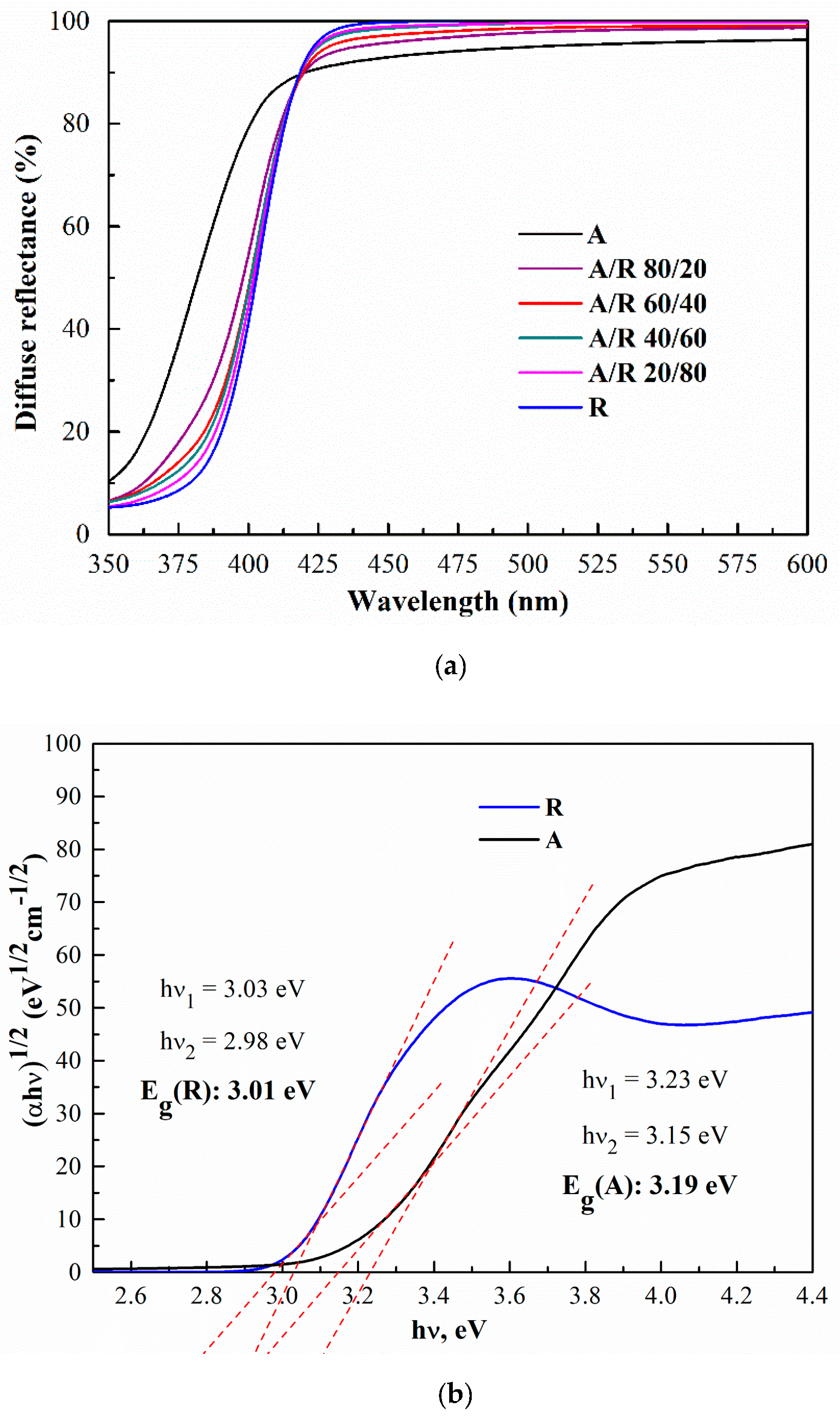
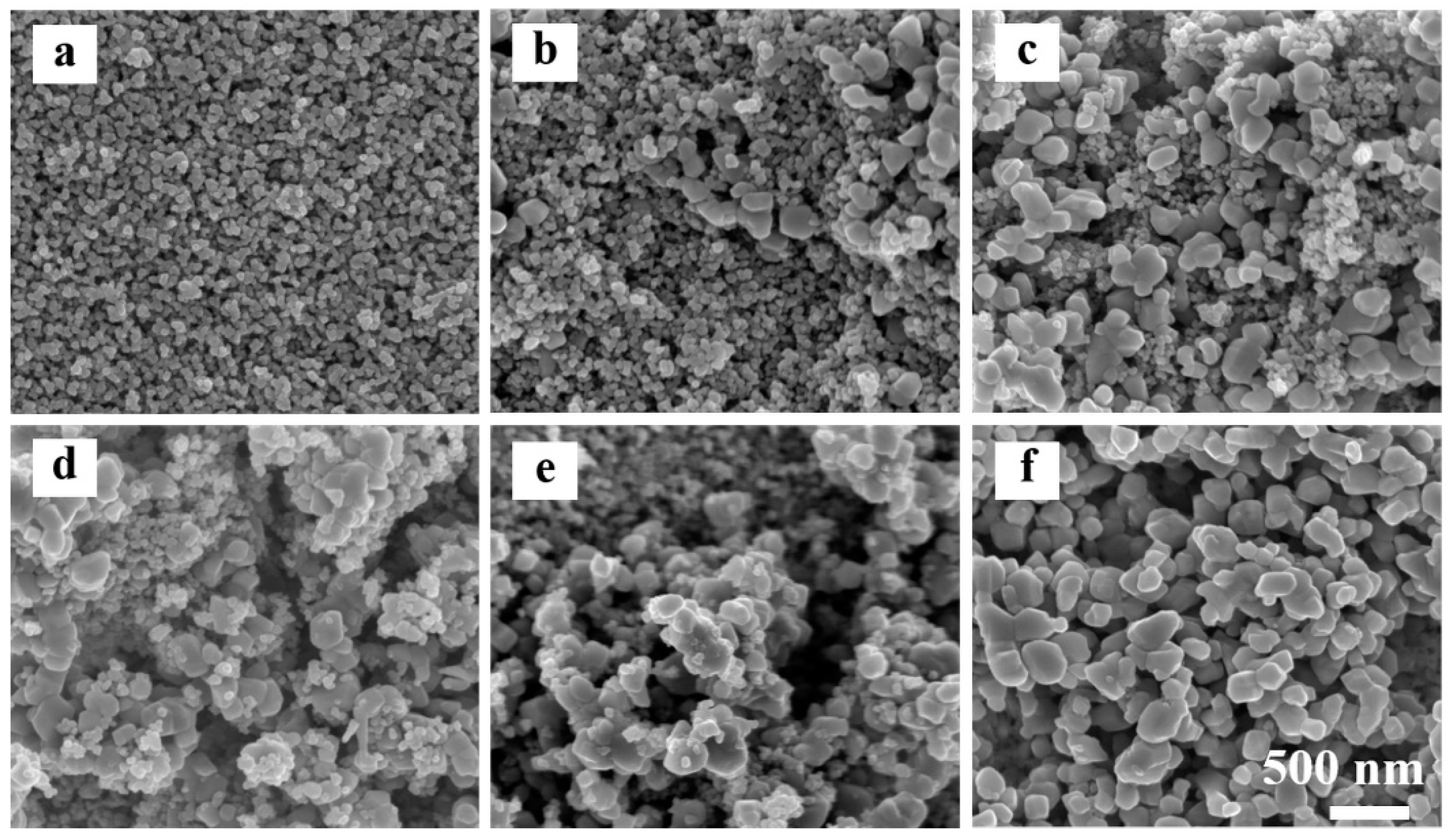
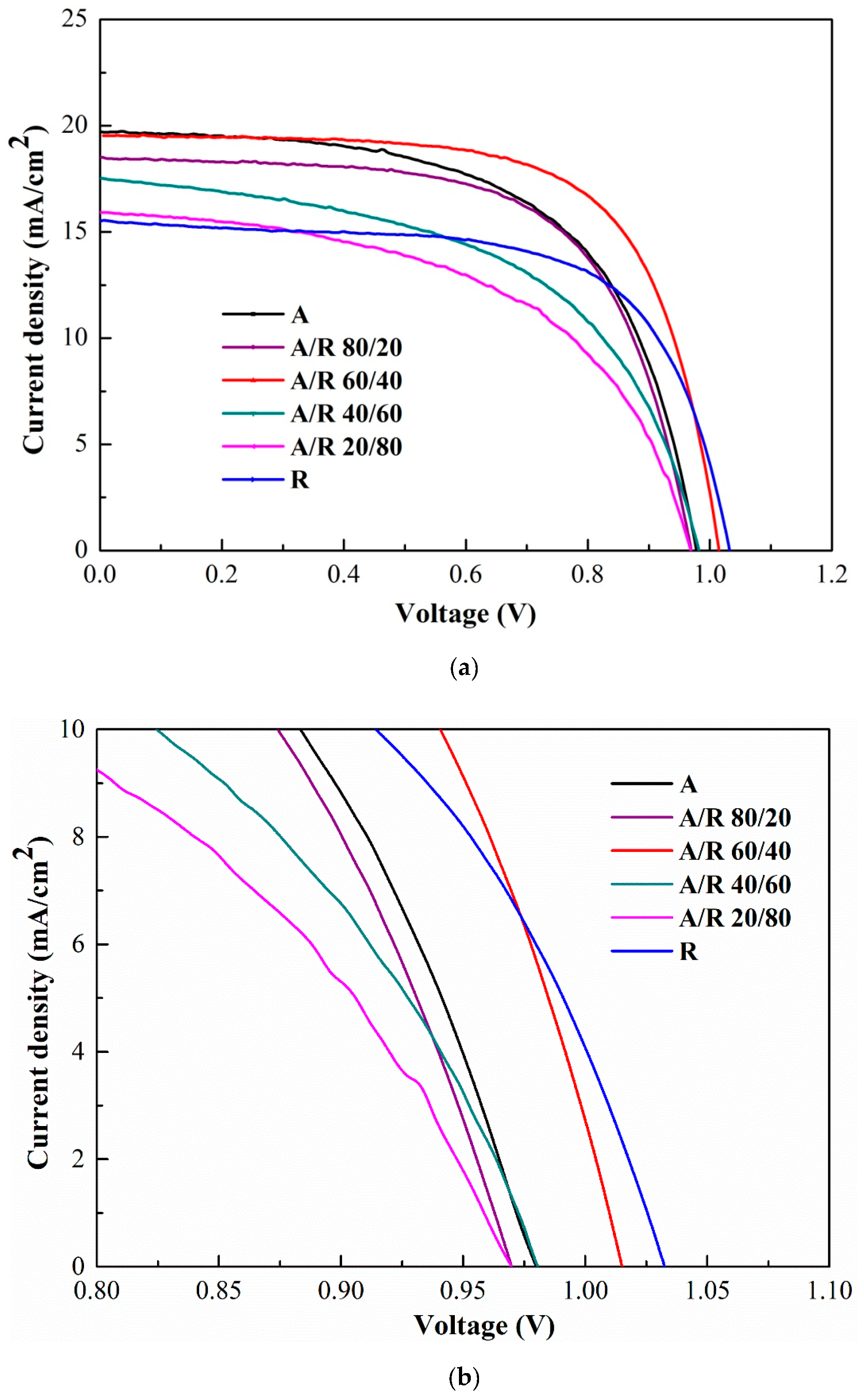
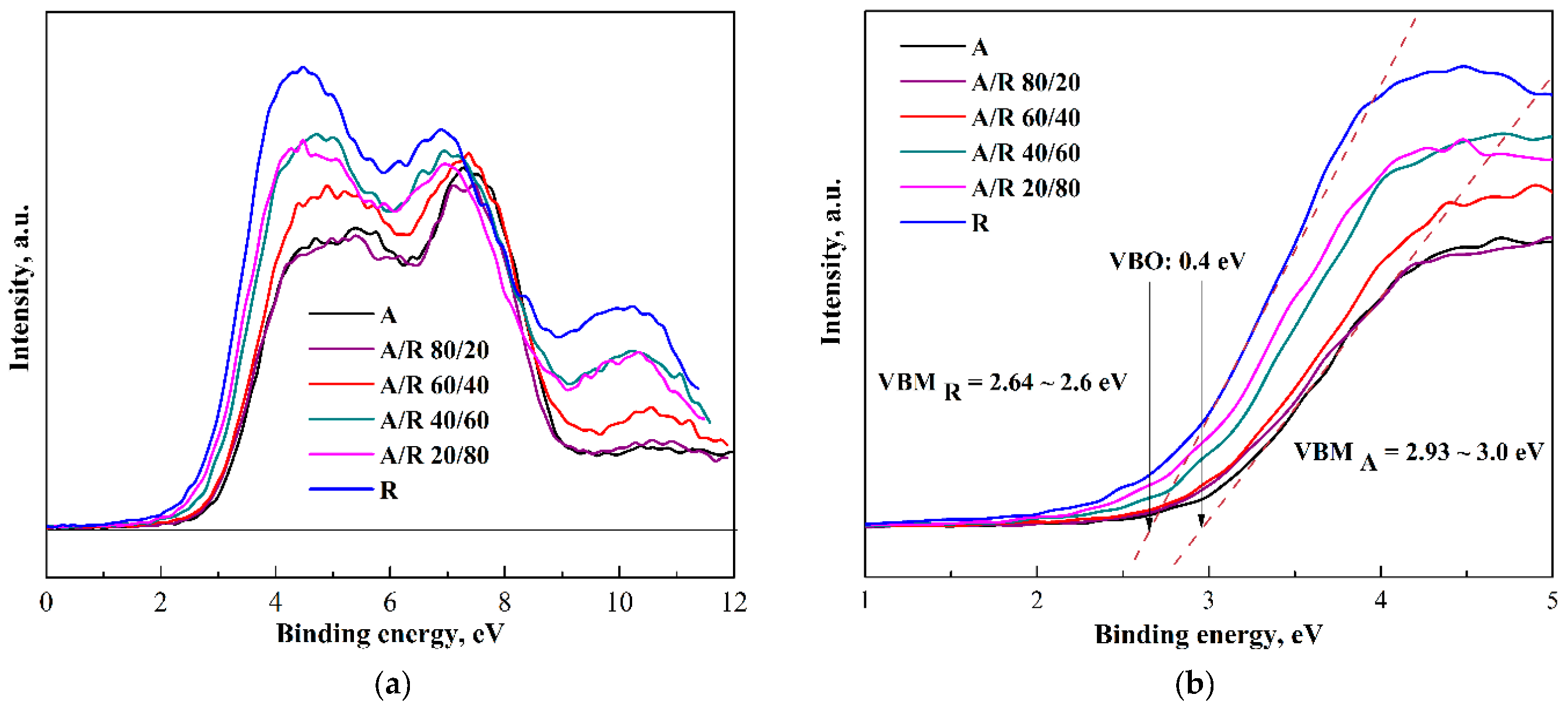
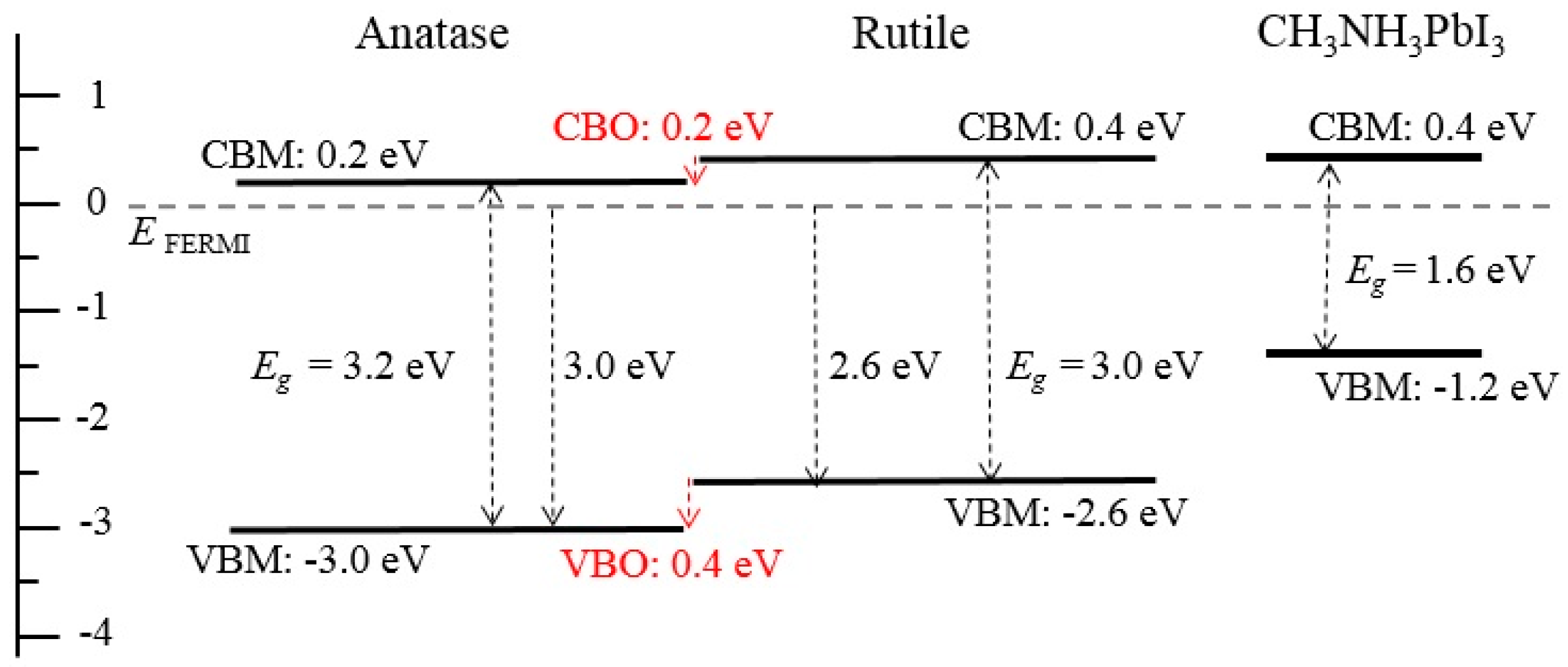
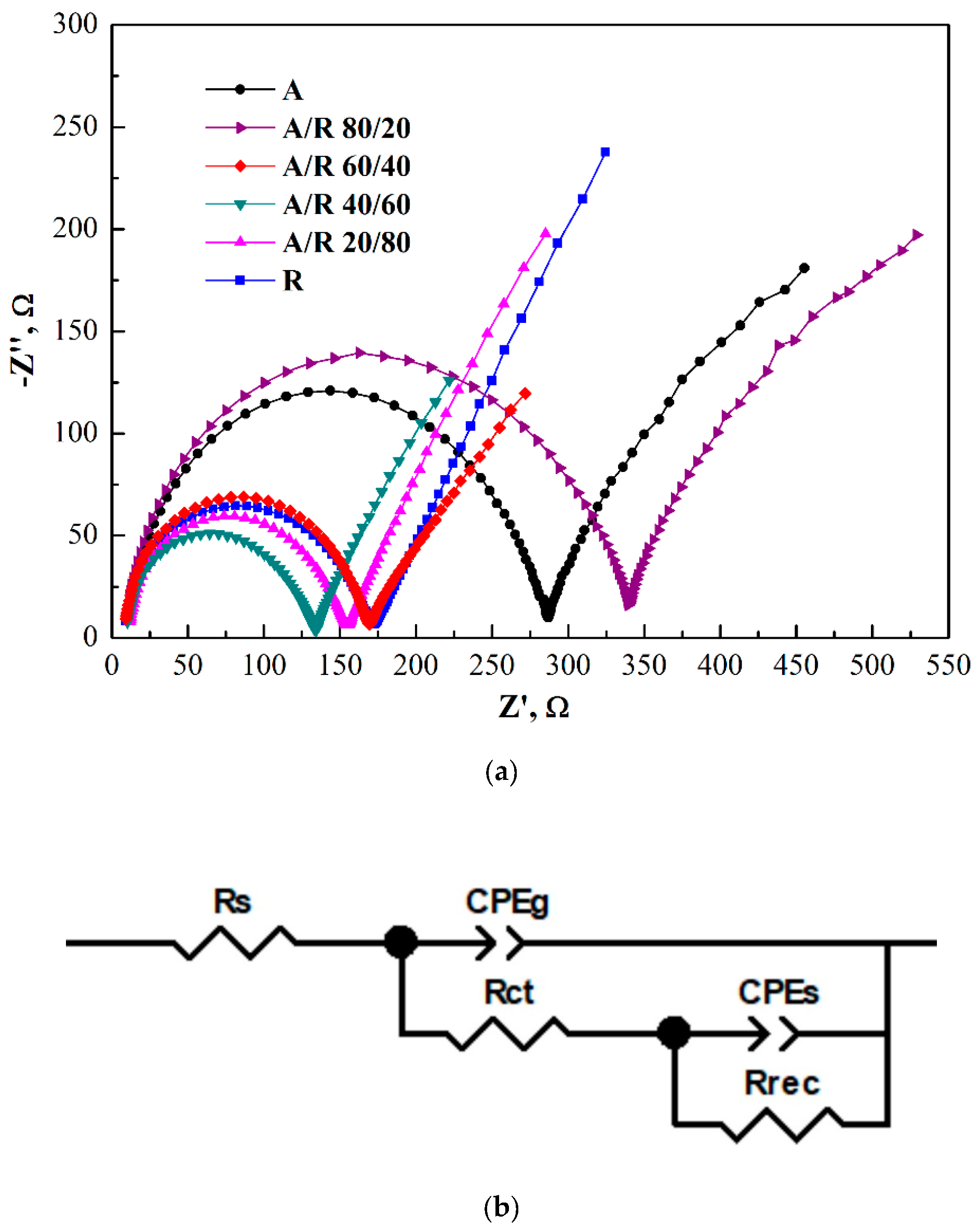
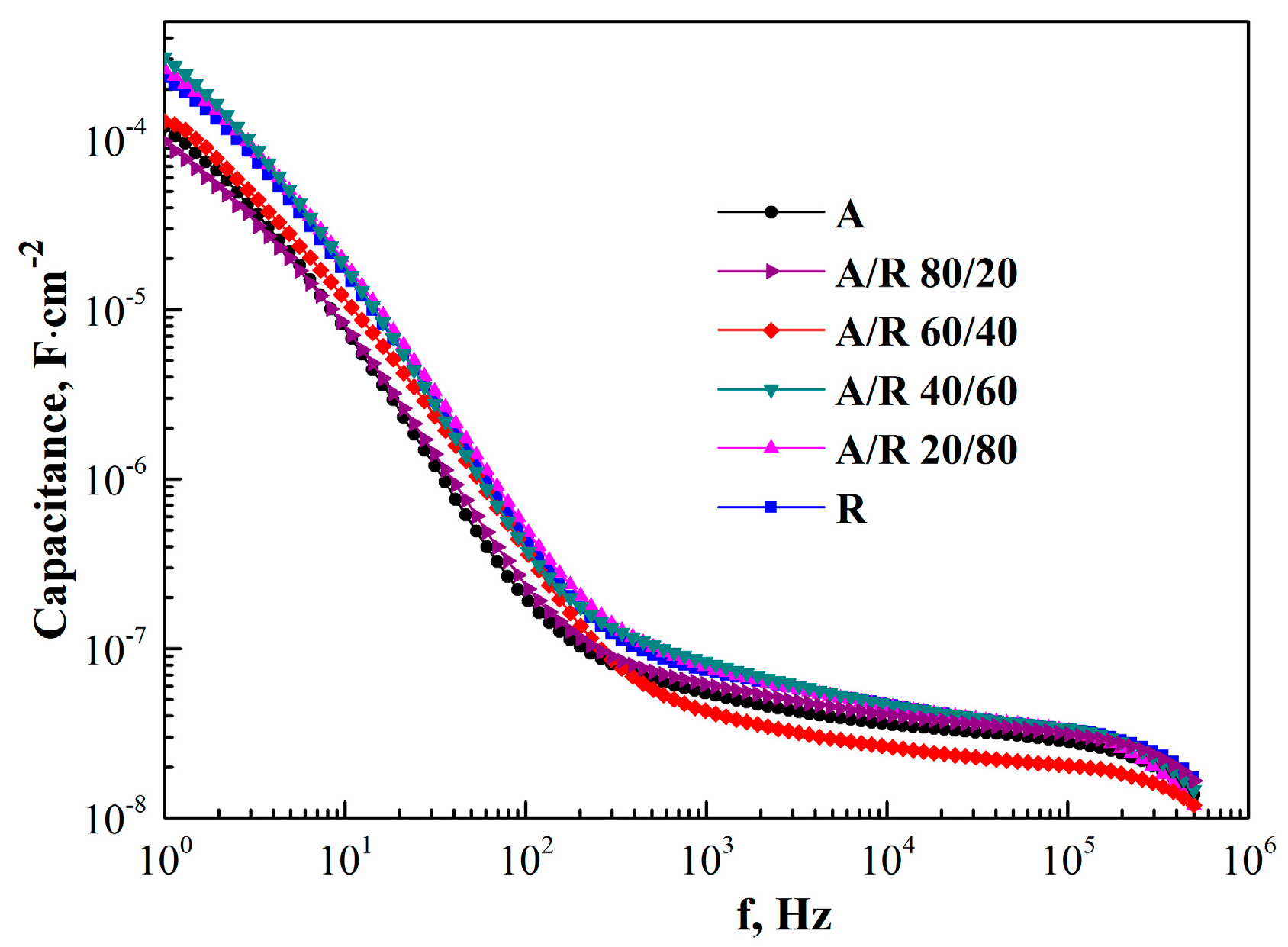
| Sample | Anatase Content (%) | Rutile Content (%) |
|---|---|---|
| A | 100 | 0 |
| A/R 80/20 | 81.5 | 18.5 |
| A/R 60/40 | 60.1 | 39.9 |
| A/R 40/60 | 41.6 | 58.4 |
| A/R 20/80 | 21.7 | 78.3 |
| R | 0 | 100 |
| Sample | JSC (mA/cm2) | VOC (V) | FF | PCE (%) |
|---|---|---|---|---|
| A | 19.6 ± 0.18 | 0.98 ± 0.01 | 0.60 ± 0.013 | 11.6 ± 0.68 |
| A/R 80/20 | 18.5 ± 0.12 | 0.97 ± 0.01 | 0.64 ± 0.008 | 11.4 ± 0.9 |
| A/R 60/40 | 19.5 ± 0.14 | 1.02 ± 0.01 | 0.67 ± 0.007 | 13.4 ± 0.70 |
| A/R 40/60 | 17.5 ± 0.13 | 0.98 ± 0.01 | 0.53 ± 0.006 | 9.2 ± 0.72 |
| A/R 20/80 | 15.9 ± 0.15 | 0.97 ± 0.01 | 0.53 ± 0.007 | 8.2 ± 0.68 |
| R | 15.5 ± 0.17 | 1.03 ± 0.01 | 0.66 ± 0.007 | 10.5 ± 0.66 |
| Sample | A | A/R 80/20 | A/R 60/40 | A/R 40/60 | A/R 20/80 | R |
|---|---|---|---|---|---|---|
| VBM (eV) | 2.97 | 2.80 | 2.84 | 2.74 | 2.69 | 2.63 |
| Sample | Rs (Ω) | Rct (Ω) | Chf·108 (F/cm2) | Rrec (Ω) | Clf·104 (F/cm2) |
|---|---|---|---|---|---|
| A | 9.7 | 273.0 | 8.6 | 603.0 | 7.8 |
| A/R 80/20 | 7.7 | 326.0 | 7.8 | 700.0 | 6.7 |
| A/R 60/40 | 8.4 | 156.0 | 7.8 | 2400.0 | 15.5 |
| A/R 40/60 | 9.4 | 122.0 | 6.6 | 1150.0 | 18.9 |
| A/R 20/80 | 10.2 | 140.0 | 6.7 | 1700.0 | 12.5 |
| R | 7.6 | 161.0 | 6.8 | 3260.0 | 10.5 |
© 2020 by the authors. Licensee MDPI, Basel, Switzerland. This article is an open access article distributed under the terms and conditions of the Creative Commons Attribution (CC BY) license (http://creativecommons.org/licenses/by/4.0/).
Share and Cite
Nikolskaia, A.; Vildanova, M.; Kozlov, S.; Tsvetkov, N.; Larina, L.; Shevaleevskiy, O. Charge Transfer in Mixed-Phase TiO2 Photoelectrodes for Perovskite Solar Cells. Sustainability 2020, 12, 788. https://doi.org/10.3390/su12030788
Nikolskaia A, Vildanova M, Kozlov S, Tsvetkov N, Larina L, Shevaleevskiy O. Charge Transfer in Mixed-Phase TiO2 Photoelectrodes for Perovskite Solar Cells. Sustainability. 2020; 12(3):788. https://doi.org/10.3390/su12030788
Chicago/Turabian StyleNikolskaia, Anna, Marina Vildanova, Sergey Kozlov, Nikolai Tsvetkov, Liudmila Larina, and Oleg Shevaleevskiy. 2020. "Charge Transfer in Mixed-Phase TiO2 Photoelectrodes for Perovskite Solar Cells" Sustainability 12, no. 3: 788. https://doi.org/10.3390/su12030788





